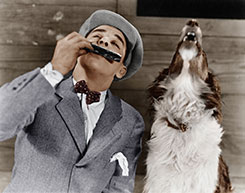
Asking Team Why it Clicks Reveals Surprising Word
What makes a happy and healthy team? I could tell you what I think, but maybe it makes more sense to go directly to an actual team that fits the description. I asked members of our creative team to share their thoughts, expecting to hear about a “hardworking yet fun atmosphere” and buzzwords like “accountability,” “flexibility,” and “recognition.”
If those topics didn’t surface, I was sure they’d bring up the almost constant flow of food. Some recent memorable snacks: odd flavors of Lay’s Potato Chips and Pringles, disturbingly elongated cotton candy grapes, and, of course, Starbucks’ terrifying Unicorn Frappuccino®.
I’d love to say that I nailed it, proving I have my fingers on my team’s pulse—which has been a little fast since that Unicorn drink—but that’s not the case. The surprise came when I heard the word “respect” again and again.
How could a concept as formal and stuffy as “respect” trump fun, flexibility, and an endless buffet?
It All Begins with Respect
What exactly did they mean when they talked about the value of respect? As you’ll see in their comments below, respect isn’t just a buzzword or formal competency they’re measured against. It’s a tangible and powerful thing that supports them in many positive ways.
“The high level of respect everyone has for each other makes it easy for us to be open about our workloads without fear of judgment and creates an amicable environment where everyone can be comfortable being themselves. I think that’s incredibly important in a team…”
“If someone has a senior or assistant title, there’s no lesser respect for either one from anyone in the department, and anyone who has direct reports isn’t seen as strictly ‘the boss.’ It’s an enabling relationship that keeps projects and people running smoothly.”
Respect Leads to Gobs of Collaboration
So, respect leads to a judgment-free zone, smoothes processes, and fights the forces of ego? Those are some pretty awesome benefits in and of themselves. Add collaboration, increased quality, and fun to the mix, and things get even more interesting:
“In my opinion, the real killer of collaboration is the unchallenged belief that you know best. We avoid that because, as a group, we have built so much mutual trust and respect. We all know and respect that our colleagues are talented, intelligent, and dedicated; we see it daily.”
“… people feel fulfilled, not put out, when they help each other, which not only ensures that the work will get done, but also that it will be done well and that we’ll put effort in because we want to, not because we feel like we have to.”
“My team members view problems and opportunities through a different lens than I do, and when we work together and combine our different views, we have the vision to deliver a stronger finished product.
“… we appreciate that collaboration increases our satisfaction with our work by increasing the variety of the tasks we work on, exposing us to new (and potentially better) strategies for working with various stakeholders and completing our work, and being more fun than working in a silo.”

How to Make It Happen
The benefits of team members who respect one another seem pretty clear. As is always the case with anything that offers such a massive return, the trick is finding ways to get it started and keep it moving.
Here’s what the team had to say on this topic:
“It really has to happen from the ground up, but I think one tip others can use to help them reach this point is to share as much as possible: share your ideas, your successes and failures, your efforts, and your time, energy, and attitude. Over time, people will eventually see the bigger picture of, and therefore the value in, what you do. Eventually, they’ll come to believe that you’ll bring this value to everything you do.”
“I feel a big portion of collaboration is just understanding what your peers are doing and why it’s important. This can be expanded by actually helping out and learning what your peers do.”
“Hiring the right people: cherrypick people who are intrinsically motivated to work hard and excel and take on extra work, etc. We aren’t people who coast when we aren’t being watched. That leads to increased collaboration because there’s no deadweight. We know that someone who is frantic really has too much work—and we’re motivated to help them because it’s not in our nature to not do work that needs doing.”
A Final Thought
At the end of the day, it’s all about the people. Get that right, and respect, collaboration, and all of the other great things mentioned by the team flow from there.
Of course there’s a lot to getting it right, and the process doesn’t have a finish line. Some of the keys to the people puzzle are skilled networking and recruiting, truly valuing and caring about staff, and making and correcting inevitable mistakes along the way.
Watch for future posts on these and other aspects of fostering healthy and happy teams.
Be the first to know about the latest news and events from AMC. Sign up for our bimonthly emails!


